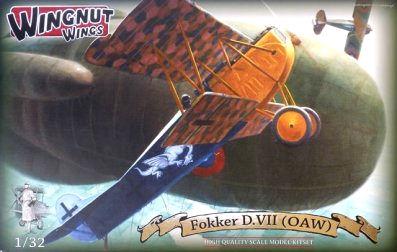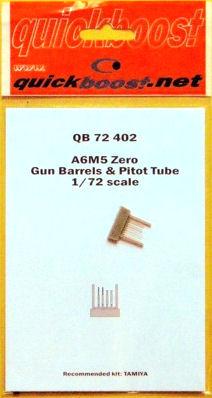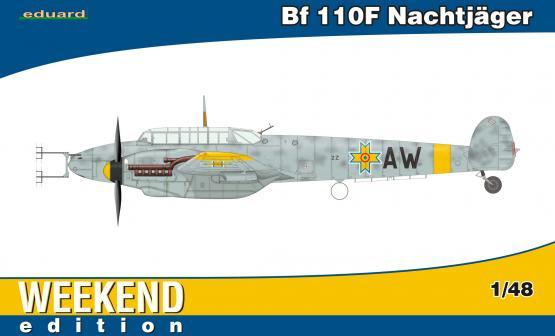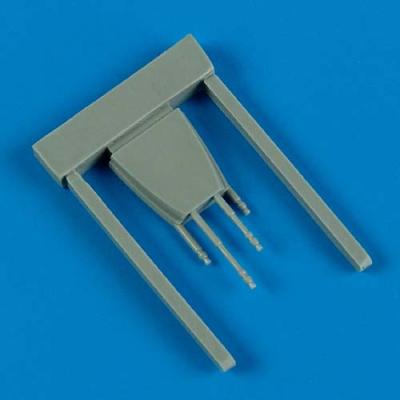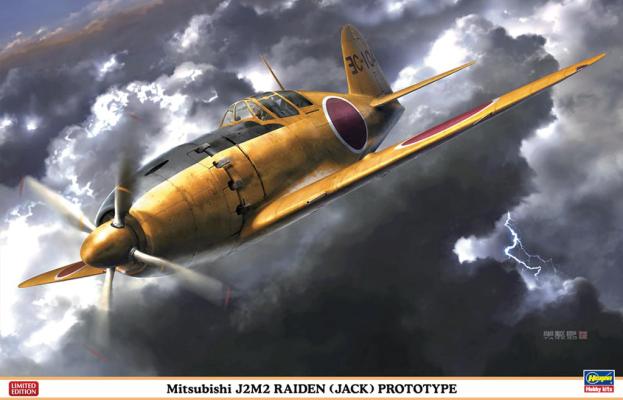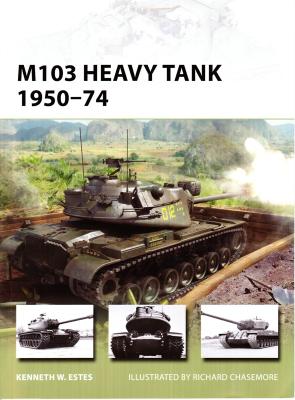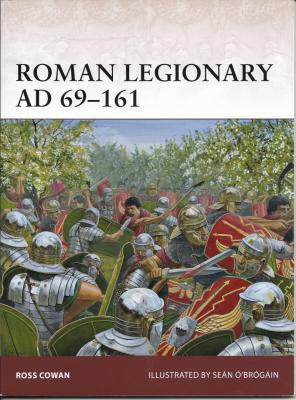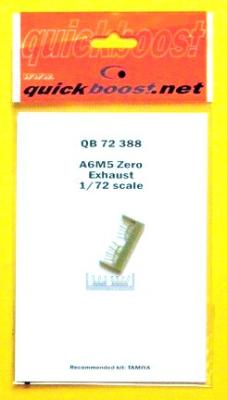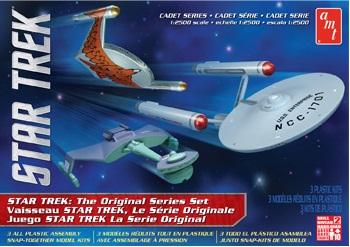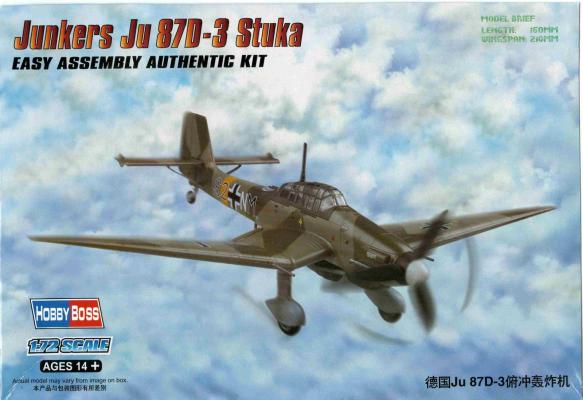The D.VII is my first go at a Wingnut Wings (WNW) kit, and I chose it for several reasons. The D.VII is one of the most recognizable aircraft used in World War I, perhaps even more so than the Dr. I. That having been said, the most significant feature that put this kit above the other WNW offerings for me was the sparse rigging that would be required. I don’t mind rigging per se, having tackled a number of 1/48th kits that are fully rigged, but I did not want to make my initial WNW project any more difficult or complex than it needed to be by adding rigging to the process.
Reviews
Quickboost now offers model builders an aftermarket detail set that replaces the wing gun barrels and pitot tube found in Tamiya’s 1/72 A6M5 kit. The parts provide a higher level of detail and accuracy, and the gun barrels are molded with open ends. The parts are designed simply to drop-in, in place of the kit part, and provide better detail.
The parts are molded in Quickboost’s familiar resin on a small casting block with protective bars on the ends. The quality of the molding is quite flawless, with no bubbles, pinholes, or flash to deal with. A sharp #11 X-Acto blade or razor saw blade is the only tool needed to remove the parts from the casting block, and a quick swipe with a sanding stick can dress up the cut, if necessary. Because they are resin, they must be anchored with superglue or epoxy cement.
These detail parts will be a very nice addition to the 1/72 scale Tamiya 1/72 A6M5 kit. This set is highly recommended.
The Bf-110F was a transitional aircraft. It was put in place with the failure of the Me-210. It was an interim until the G-2 could be produced in numbers. Only 500 were made, divided between night fighters and fighter bombers.
Interestingly, Eduard elected to release the F as a weekend edition. This is the first time that the Bf-110F has been available in any scale that I know of. This cardboard box is so jam-packed with plastic it is surprising to me that it costs so little. Because of the transitional status of the real aircraft, it had features of the older E model and the newer still-to-come G model. Eduard’s parts break down shows this transitional parts listing, necessitating the parts from each of the earlier releases. There are a lot of extra parts because of it, even extra fuselage halves.
Quickboost has produced a set of resin gun barrels to replace the nose armament for the Eduard Bf-110E kit. The only real differences between the kit and replacement parts are that the resin part is one piece, whereas the kit parts need to be glued together, and the gun barrels are drilled out, allowing for more realism. Once installed, the gun barrels are barely visible, although the drilled out muzzles do stand out, and the parts are so small that drilling them out could be a bit tedious at best.
This is a nice little addition to what is already an excellent kit. Recommended. My thanks to Quickboost and to IPMS/USA for the opportunity to review these items.
The J2M series of aircraft were designed by Dr. Jiro Horikoshi who also was responsible for the Zero / Zeke design. The J2M (Allied code name “Jack”) was designed in 1939 and first flown in March of 1942. A total of 621 J2M Raiden (Japanese for Thunderbolt) series of aircraft J2M1 through J2M6 were produced with the M2 and M3 accounting for 438 of the total built.
Following the conclusion of World War II the U.S. Army and the U.S.M.C. were in dire need of a heavy tank to keep up with the Soviet armor force. After many years of development and testing the M103 was ready to go into production. Through the development of the M103 there were several variants developed. The main variant being the M51 heavy tank recovery vehicle. The M103 never served in a war zone, but was deployed in Germany and, of all places, Guantanamo, Cuba. The M103 was retired after only fourteen years of operational service.
The author and Osprey publishing do a very good job of telling how the M103 came to be and then finally being put into service. The writing is very clear and they use photos and artist drawings of the M103 in combat, which it never was, just kind of a "what if" type of artist's rendering.
One interesting side note is that there is a local military museum that has an M103 turret as one of their displays.
I am a big fan of Osprey books and I have quite a few in my collection and find they usually provide all the information needed to research a model. This book by Ross Cowan is no exception, and it is a follow-up book to his work Roman Legionary, 58 BC – AD69, which was published in 2003 by Osprey.
The Roman Legionary in the prime of the Empire was a fine tuned fighting machine. Kept in shape by constant labor, such as building forts and roads, their universal training meant that Legions from opposite ends of the empire could fight alongside each other seamlessly. Each man knew his place and function in the battle lines.
This is not to mean that the Romans were unbeatable. There are several cases of Legions (Approximately 5000 men at full strength) being destroyed or vanishing during our time period. Also, with rebellious leaders trying to seize control of the Empire, it was not uncommon for Legion to face Legion in battle.
Quickboost now offers model builders an aftermarket detail set that replaces the exhaust pipes found in Tamiya’s great 1/72 A6M5 kit. As nice as the kit parts may be, these pipes provide greater detail than those in the kit because Quickboost has molded them with open ends. They are designed to simply drop in, in place of the kit parts. As the photo below shows, they match up with the kit parts exactly so adding them to the model should be a simple matter after they are removed from the casting block.
For me and all other Star Trek fans/modellers, it has really been great to watch Round2 pull out the old AMT Star Trek kit molds, re-work a few things and then re-release the oldies, in new form, and on top of that release super new kits in the same genre and in comparable scales. In the first quarter of 2013, among several other great releases, Round2/AMT re-packaged the original series (TOS) USS Enterprise with her two primary adversaries, the Klingon D-7 Battle Cruiser and the Romulan Bird-of-Pray (BoP) as the newest entry into their familiar 1/2500 scale, Cadet Series.
I want to start by thanking Round2 Models for providing this kit for review and IPMS USA for giving me the opportunity to review it.
History
When Ernst Udet brought back two Curtiss Hawk biplanes to Germany in the middle thirties after witnessing dive bombing demonstrations by US Navy pilots, he started a trend that resulted in the development of dive bombing aircraft for the Luftwaffe that eventually resulted in the development of the Junkers JU-87. Capable of nearly vertical dives retarded by very effective dive brakes, bombing accuracy improved dramatically, and during World War II, the Germans, along with the Americans and Japanese, developed dive bombing to a fine art. The Ju-87 was an early attempt at a specialized dive bomber, and although progressively developed during the war, could never keep pace with or coexist in an environment with enemy fighters unless a strong friendly fighter escort was present, a luxury the Germans didn’t always have.

